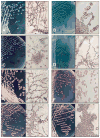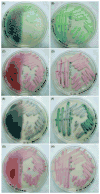Advances in Candida detection platforms for clinical and point-of-care applications
- PMID: 27093473
- PMCID: PMC5083221
- DOI: 10.3109/07388551.2016.1167667
Advances in Candida detection platforms for clinical and point-of-care applications
Abstract
Invasive candidiasis remains one of the most serious community and healthcare-acquired infections worldwide. Conventional Candida detection methods based on blood and plate culture are time-consuming and require at least 2-4 days to identify various Candida species. Despite considerable advances for candidiasis detection, the development of simple, compact and portable point-of-care diagnostics for rapid and precise testing that automatically performs cell lysis, nucleic acid extraction, purification and detection still remains a challenge. Here, we systematically review most prominent conventional and nonconventional techniques for the detection of various Candida species, including Candida staining, blood culture, serological testing and nucleic acid-based analysis. We also discuss the most advanced lab on a chip devices for candida detection.
Keywords: Blood culture; disease diagnostics; invasive Candidiasis; laboratory on a chip; loop-mediated isothermal amplification; microfluidics; nanotechnology.
Conflict of interest statement
The authors report no declarations of interest.
Figures






Similar articles
-
Simple and rapid detection of Candida albicans DNA in serum by PCR for diagnosis of invasive candidiasis.J Clin Microbiol. 2000 Aug;38(8):3016-21. doi: 10.1128/JCM.38.8.3016-3021.2000. J Clin Microbiol. 2000. PMID: 10921970 Free PMC article.
-
Establishment and Application of Multiple Cross Displacement Amplification Coupled With Lateral Flow Biosensor (MCDA-LFB) for Visual and Rapid Detection of Candida albicans in Clinical Samples.Front Cell Infect Microbiol. 2019 Apr 16;9:102. doi: 10.3389/fcimb.2019.00102. eCollection 2019. Front Cell Infect Microbiol. 2019. PMID: 31058099 Free PMC article.
-
Characterising atypical Candida albicans clinical isolates from six third-level hospitals in Bogotá, Colombia.BMC Microbiol. 2015 Oct 5;15:199. doi: 10.1186/s12866-015-0535-0. BMC Microbiol. 2015. PMID: 26438104 Free PMC article.
-
Candida albicans - Biology, molecular characterization, pathogenicity, and advances in diagnosis and control - An update.Microb Pathog. 2018 Apr;117:128-138. doi: 10.1016/j.micpath.2018.02.028. Epub 2018 Feb 16. Microb Pathog. 2018. PMID: 29454824 Review.
-
Prospects of Microfluidic Technology in Nucleic Acid Detection Approaches.Biosensors (Basel). 2023 May 27;13(6):584. doi: 10.3390/bios13060584. Biosensors (Basel). 2023. PMID: 37366949 Free PMC article. Review.
Cited by
-
PCR-Based Microarray Enhances Diagnosis of Culture-Negative Biopsied Tissue in Patients with Invasive Mold Infections: Real-World Experience in a Tertiary Medical Center.J Fungi (Basel). 2024 Jul 29;10(8):530. doi: 10.3390/jof10080530. J Fungi (Basel). 2024. PMID: 39194856 Free PMC article.
-
Visible light-regulated cationic polymer coupled with photodynamic inactivation as an effective tool for pathogen and biofilm elimination.J Nanobiotechnology. 2022 Nov 24;20(1):492. doi: 10.1186/s12951-022-01702-4. J Nanobiotechnology. 2022. PMID: 36424663 Free PMC article.
-
Single-Cell RNA Sequencing Analysis for Oncogenic Mechanisms Underlying Oral Squamous Cell Carcinoma Carcinogenesis with Candida albicans Infection.Int J Mol Sci. 2022 Apr 27;23(9):4833. doi: 10.3390/ijms23094833. Int J Mol Sci. 2022. PMID: 35563222 Free PMC article.
-
Molecular identification of Candida species isolated from candiduria and its risk factors in neonates and children.Curr Med Mycol. 2021 Sep;7(3):9-12. doi: 10.18502/cmm.7.3.7799. Curr Med Mycol. 2021. PMID: 35528621 Free PMC article.
-
Thread integrated smart-phone imaging facilitates early turning point colorimetric assay for microbes.RSC Adv. 2020 Jul 17;10(45):26853-26861. doi: 10.1039/d0ra05190j. eCollection 2020 Jul 15. RSC Adv. 2020. PMID: 35515782 Free PMC article.
References
-
- De Hoog G, Guarro J, Gene J, et al. Atlas of clinical fungi Centraalbureau voor Schimmelcultures. Universitat Rovira i Virgili, Amer Society for Microbiology; 2000. pp. 164–174.
-
- Phaff HJ. Yeasts eLS. 2001. pp. 1–11.
-
- Kulp K. Handbook of Cereal Science and Technology, Revised and Expanded. CRC; 2000.
Publication types
MeSH terms
Grants and funding
LinkOut - more resources
Full Text Sources
Other Literature Sources
Medical
Miscellaneous
